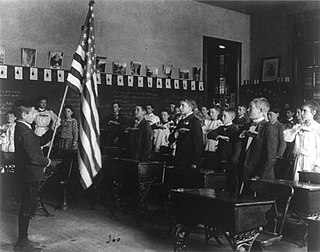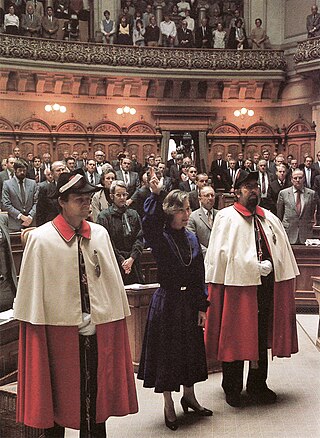
A salute is usually a formal hand gesture or other action used to display respect in military situations. Salutes are primarily associated with the military and law enforcement, but many civilian organizations, such as Girl Guides, Boy Scouts and the Salvation Army use formal salutes. Ordinary civilians also salute informally to greet or acknowledge the presence of another person, such as a tip of the hat or a hand wave to a friend or neighbor.

"The Star-Spangled Banner" is the national anthem of the United States. The lyrics come from the "Defence of Fort M'Henry", a poem written by American lawyer Francis Scott Key on September 14, 1814, after he witnessed the bombardment of Fort McHenry by the British Royal Navy during the Battle of Baltimore in the War of 1812. Key was inspired by the large U.S. flag, with 15 stars and 15 stripes, known as the Star-Spangled Banner, flying triumphantly above the fort after the battle.

The Pledge of Allegiance is a patriotic recited verse that promises allegiance to the flag of the United States and the republic of the United States of America. The first version was written in 1885 by Captain George Thatcher Balch, a Union Army officer in the Civil War who later authored a book on how to teach patriotism to children in public schools. In 1892, Francis Bellamy revised Balch's verse as part of a magazine promotion surrounding the World's Columbian Exposition, which celebrated the 400th anniversary of Christopher Columbus' arrival in the Americas. Bellamy, the circulation manager for The Youth's Companion magazine, helped persuade then-president Benjamin Harrison to institute Columbus Day as a national holiday and lobbied Congress for a national school celebration of the day. The magazine sent leaflets containing part of Bellamy's Pledge of Allegiance to schools across the country and on October 21, 1892, over 10,000 children recited the verse together.

Francis Julius Bellamy was an American Christian socialist Baptist minister and author. He is best known for writing the original version of the Pledge of Allegiance in 1892.
West Virginia State Board of Education v. Barnette, 319 U.S. 624 (1943), is a landmark decision by the United States Supreme Court holding that the First Amendment protects students from being compelled to salute the American flag or say the Pledge of Allegiance in public schools.
Minersville School District v. Gobitis, 310 U.S. 586 (1940), was a decision by the Supreme Court of the United States restricting the religious rights of public school students under the First Amendment to the United States Constitution. The Court ruled that public schools could compel students—in this case, Jehovah's Witnesses—to salute the American flag and recite the Pledge of Allegiance despite the students' religious objections to these practices. This decision led to increased persecution of Witnesses in the United States. The Supreme Court overruled this decision three years later in West Virginia State Board of Education v. Barnette (1943).
The America First Committee (AFC) was an American isolationist pressure group against the United States' entry into World War II. Launched in September 1940, it surpassed 800,000 members in 450 chapters at its peak. The AFC principally supported isolationism for its own sake, and its varied coalition included Republicans, Democrats, farmers, industrialists, communists, anti-communists, students, and journalists – however, it was controversial for the anti-Semitic and pro-fascist views of some of its most prominent speakers, leaders, and members. The AFC was dissolved on December 11, 1941, four days after the attack on Pearl Harbor brought the United States into the war.

The Roman salute, also known as the Fascist salute, is a gesture in which the right arm is fully extended, facing forward, with palm down and fingers touching. In some versions, the arm is raised upward at an angle; in others, it is held out parallel to the ground. In contemporary times, the former is commonly considered a symbol of fascism that had been based on a custom popularly attributed to ancient Rome. However, no Roman text gives this description, and the Roman works of art that display salutational gestures bear little resemblance to the modern Roman salute.

Hand-kissing is a greeting gesture that indicates courtesy, politeness, respect, admiration, affection or even devotion by one person toward another. A hand-kiss is considered a respectful way for a gentleman to greet a lady. Today, non-ritual hand-kissing is rare and takes place mostly within conservative class or diplomatic contexts. Today, the hand kiss has largely been replaced by a kiss on the cheek or a handshake.

The raised fist, or the clenched fist, is a long-standing image of mixed meaning, often a symbol of solidarity, especially with a political movement. It is a common symbol representing a wide range of political ideologies, most notably socialism, communism, anarchism, and trade unionism, and can also be used as a salute expressing unity, strength, or resistance.

Fascist symbolism is the use of certain images and symbols which are designed to represent aspects of fascism. These include national symbols of historical importance, goals, and political policies. The best-known are the fasces, which was the original symbol of fascism, and the swastika of Nazism.

Burton Kendall Wheeler was an attorney and an American politician of the Democratic Party in Montana, which he represented as a United States senator from 1923 until 1947.

The Christian Flag is an ecumenical flag designed in the late 19th century to represent much of Christianity and Christendom. Since its adoption by the United States Federal Council of Churches in 1942, it has had varied usage by congregations of many Christian traditions, including Anglican, Baptist, Congregationalist, Lutheran, Mennonite, Methodist, Moravian, Presbyterian, and Reformed, among others.

Kathleen Thompson Norris was an American novelist and newspaper columnist. She was one of the most widely read and highest paid female writers in the United States for nearly fifty years, from 1911 to 1959. Norris was a prolific writer who wrote 93 novels, many of which became best sellers. Her stories appeared frequently in the popular press of the day, including The Atlantic, The American Magazine, McClure's, Everybody's, Ladies' Home Journal, and Woman's Home Companion. Norris used her fiction to promote family and moralistic values, such as the sanctity of marriage, the nobility of motherhood, and the importance of service to others.
A salute is a gesture or other action used to indicate respect.
The Pledge of Allegiance of the United States has been criticized on several grounds. Its use in government funded schools has been the most controversial, as critics contend that a government-sanctioned endorsement of religion violates the Establishment Clause of the First Amendment to the U.S. Constitution. Arguments against the pledge include that the pledge itself is incompatible with democracy and freedom, that it is a form of nationalistic indoctrination, that pledges of allegiance are features of current and former totalitarian states such as Nazi Germany, and that the pledge was written to sell flags.
The following is a timeline of the flag of the United States.

The Nazi salute, also known as the Hitler salute, or the Sieg Heil salute, is a gesture that was used as a greeting in Nazi Germany. The salute is performed by extending the right arm from the shoulder into the air with a straightened hand. Usually, the person offering the salute would say "Heil Hitler!", "Heil, mein Führer!", or "Sieg Heil!". It was officially adopted by the Nazi Party in 1926, although it had been used within the party as early as 1921, to signal obedience to the party's leader, Adolf Hitler, and to glorify the German nation. The salute was mandatory for civilians but mostly optional for military personnel, who retained a traditional military salute until the failed assassination attempt on Hitler on 20 July 1944.

The Schwurhand is a heraldic charge depicting the hand gesture that is used in Germanic Europe and neighbouring countries, when swearing an oath in court, in office, or in swearing-in. The right hand is raised, with the index finger and middle finger extended upwards; the last two digits are curled downwards against the palm. The thumb is shown slightly curled or raised.

















